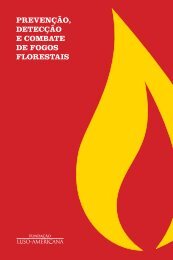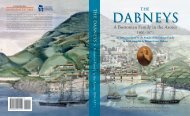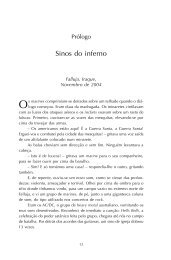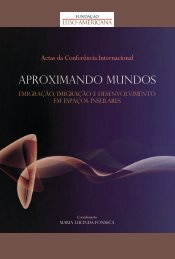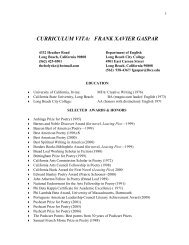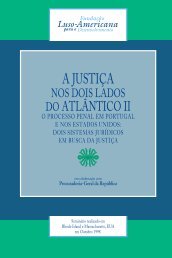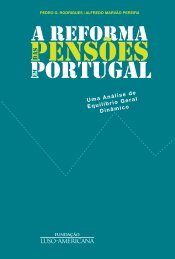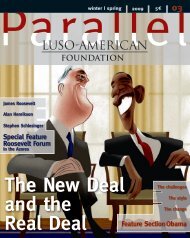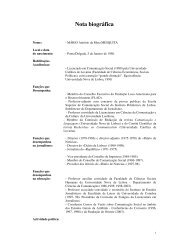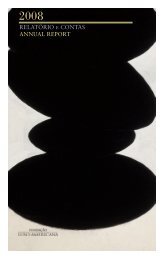A decade later - Fundação Luso-Americana
A decade later - Fundação Luso-Americana
A decade later - Fundação Luso-Americana
Create successful ePaper yourself
Turn your PDF publications into a flip-book with our unique Google optimized e-Paper software.
At times alone. At times accompanied. Was the world already there<br />
before there was reflection? The small scenes explore, to the saturation<br />
point, the enigmatic relationship between a double that is<br />
either opposing or facing his double; they isolate the figures by<br />
replicating them; they make us query the paradoxal originality of<br />
the other, the one that reproduces by replicating itself infinitely,<br />
conveying subtlety, tension, and deceptive fragility in seductive<br />
but potentially aggressive body moves. We draw closer. The images<br />
are fairly opaque, thick, dense, shadowy, obscure, faded almost<br />
unfocused – can clarity be destroyed by clarity? – ill-defined,<br />
precarious, somewhere between “fainting, falling, fading and<br />
faking” (the title of a text by Delfim Sardo in Luxury Bound). Jorge<br />
Molder, whose essentially photographic work is, according to a<br />
number of critics, about “duplicity,” fences with an impressive<br />
dearth of resources, with arguments that duel over the inevitable,<br />
uncanny division of the self. What we see are small Polaroid images<br />
taken from a number of video-recordings Molder made on<br />
the movements of the body during a fencing match. Two bodies<br />
– or figures (or maybe a duplicated body) are wearing the usual<br />
white suits and protective masks that both conceal and reveal the<br />
face. The naked hands relate to each other at different moments<br />
though different poses/gestures, in an arena whose hazy background<br />
is lit by a circular focus-light, expressively delineating a<br />
here and now – hic et nunc – that is almost archaic, germinal,<br />
seminal and symbolic, but one that immediately transports us to<br />
a timeless before and after: “still not a not-any-more.” A past that<br />
is the future perhaps. For João Miguel Fernandes Jorge, “the<br />
Polaroids strengthen the potential reach of that living past.” As he<br />
writes about Molder, he stresses the importance of “being ‘en<br />
garde.’ The Duelers are his domain. In this work, the photographs<br />
are his thoughts exactly. The on-target thrusts constantly lead us<br />
to turn back to the photograph. They create a need for time – and<br />
more time – to examine the consistency of a face that recoils in<br />
flight (and fusion) at every instance into the blackness of the<br />
background.” (text by João Miguel Fernandes<br />
Jorge in the catalogue “Algum Tempo Antes/<br />
Algun Tiempo Antes”, 2006). Discreetly revealed<br />
is a paradoxical dialectic involving mirroring<br />
and a seductive interplay of closing and disclosing<br />
using two perspectives in each one of us,<br />
without time and objective space: Il faut que je sois<br />
mon extérieur, et que le corps d’autrui soit lui-même” (M.<br />
Merleau-Ponty, Phénoménologie de la Perception).<br />
The Polaroid series esgrimitas (the Fencers) is<br />
cited over and over again in texts on Molder’s<br />
career, but the texts rarely explore more than<br />
the basics. The 1986 series with 8 x 8 cm photos<br />
is complemented by two small black-andwhites<br />
(the Polaroids are taken from<br />
video-recordings and the photos are direct<br />
shots) is a quasi-distillation of a number of<br />
86<br />
FLAd ArT coLLecTion<br />
Jorge molder<br />
en garde<br />
features, topics, and pivotal points of the types of discourse<br />
Molder has produced since 1977. The concept of “series” has<br />
been essential since the beginning, as the artist has asserted. Its<br />
meaning is rooted in a “well-known philosophical concept,”<br />
having temporal allusions, and references to belonging and other<br />
attributes that are difficult to clarify. “I know very well where it<br />
begins and eventually discover when it ends, I can manage to<br />
understand the elements that it comprises but what escapes me<br />
completely is the way it works and how it comes about.” (from<br />
the artist’s website) Unfinished – with an alpha but no omega<br />
– this series dealing with the world of fencing is a window into<br />
a few of Molder’s obsessions: primarily topics related to personal<br />
doubles or doppelgangers: an offshoot creature or a replica of<br />
ourselves wandering around out there somewhere.<br />
The fencers in these works “are beings that are a bit special,”<br />
according to Jorge Molder. The clothes, gestures, and anatomy<br />
of a routine that borders on the ritualistic bespeak ideas and<br />
memories of a fundamental archetype that faces the impossible<br />
challenge of the master stroke, the perfect rapier thrust, the<br />
unstoppable, the purest creation illuminated by human talent.<br />
It is a model of inspiration and efficiency which, because of<br />
its nature, discloses a spirit of agony, in a silent duel with its<br />
own image whose reflection seems to escape the boundaries<br />
imposed by the artist, between rejection and retention, obsolescence<br />
and ritual, in constantly imprisoned flux. As George<br />
Kubler has said, “the replications that fill the story effectively<br />
prolong the stability of many past moments, allowing meaning<br />
and model to emerge whenever we turn our attention to these<br />
moments. However, it’s an imperfect instability. Any replica<br />
made by man differs from the model owing to minimal, unpremeditated<br />
differences. The cumulative effects of these differences<br />
act as a slow drift in relation to the archetype.” (A Forma do<br />
Tempo). Perhaps like making a hit while avoiding being touched<br />
by the foil. pedro Faro<br />
A graduate in Philosophy, Jorge Mol‑<br />
der (Lisbon, 1947) began his artistic<br />
career in 1977 with a solo show<br />
entitled “Vilarinho das Furnas (Uma<br />
Encenação), Paisagens com Água,<br />
Casas e Um Trailer.” In 1980, he<br />
collaborated with poets João Miguel<br />
Fernandes Jorge, and Joaquim Manuel<br />
Magalhães on “Uma Exposição”. his<br />
self‑depictions, coupled with strong<br />
references to literature, movies, and<br />
day‑to‑day life start to take shape in<br />
1987 with several series of works.<br />
In 1999, Molder is invited by Delfim<br />
Sardo to represent Portugal at the<br />
48th Venice Biennale, thus confirming<br />
him as one of Portugal’s most impor‑<br />
tant contemporary artists. he was the<br />
director of the Calouste Gulbenkian<br />
Foundation’s Modern Art Center from<br />
1993 to 2009. Jorge Molder’s work<br />
can be found in a number of distin‑<br />
guished Portuguese and international<br />
art collections.<br />
Parallel no. 6 | FALL | WINTER 2011





